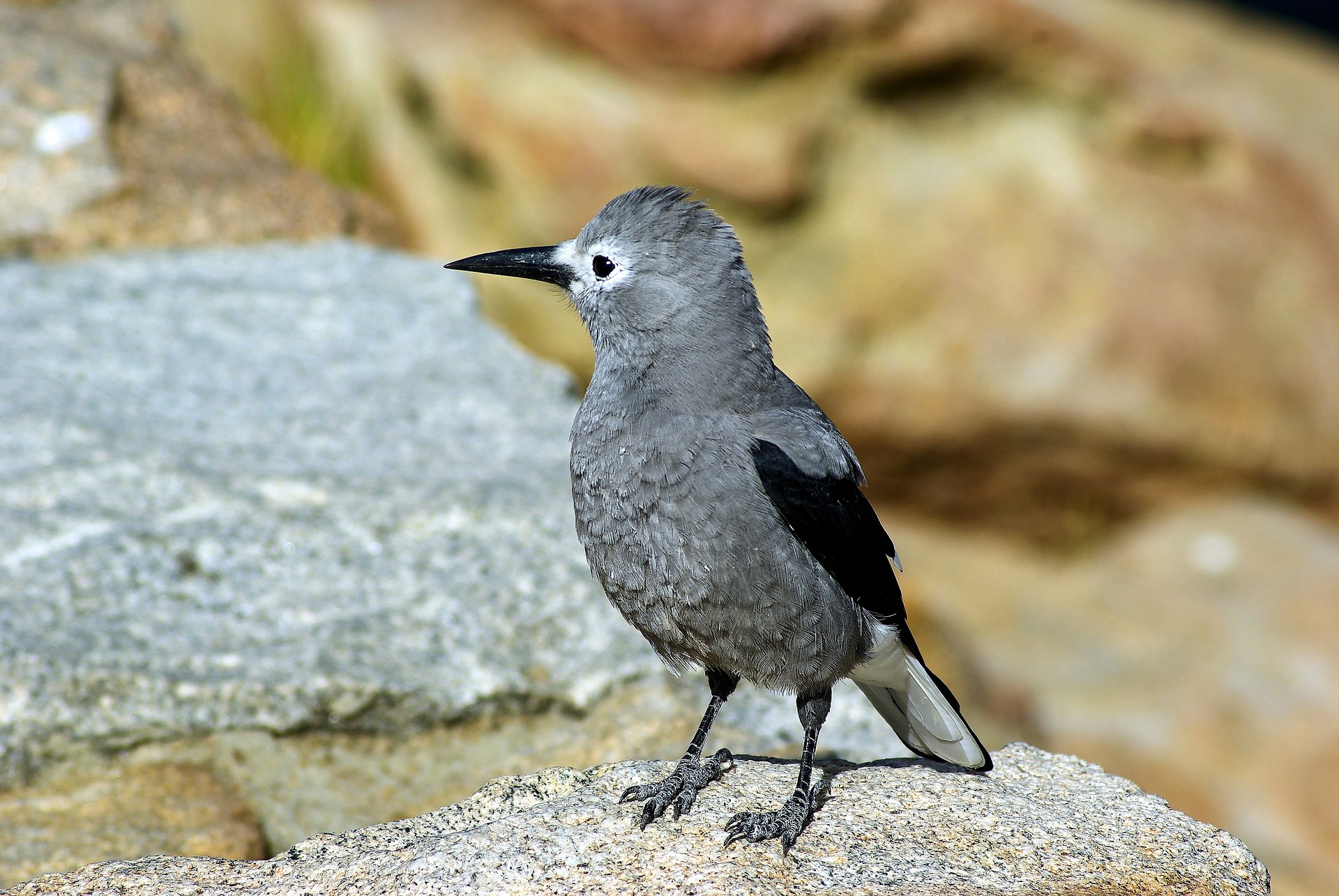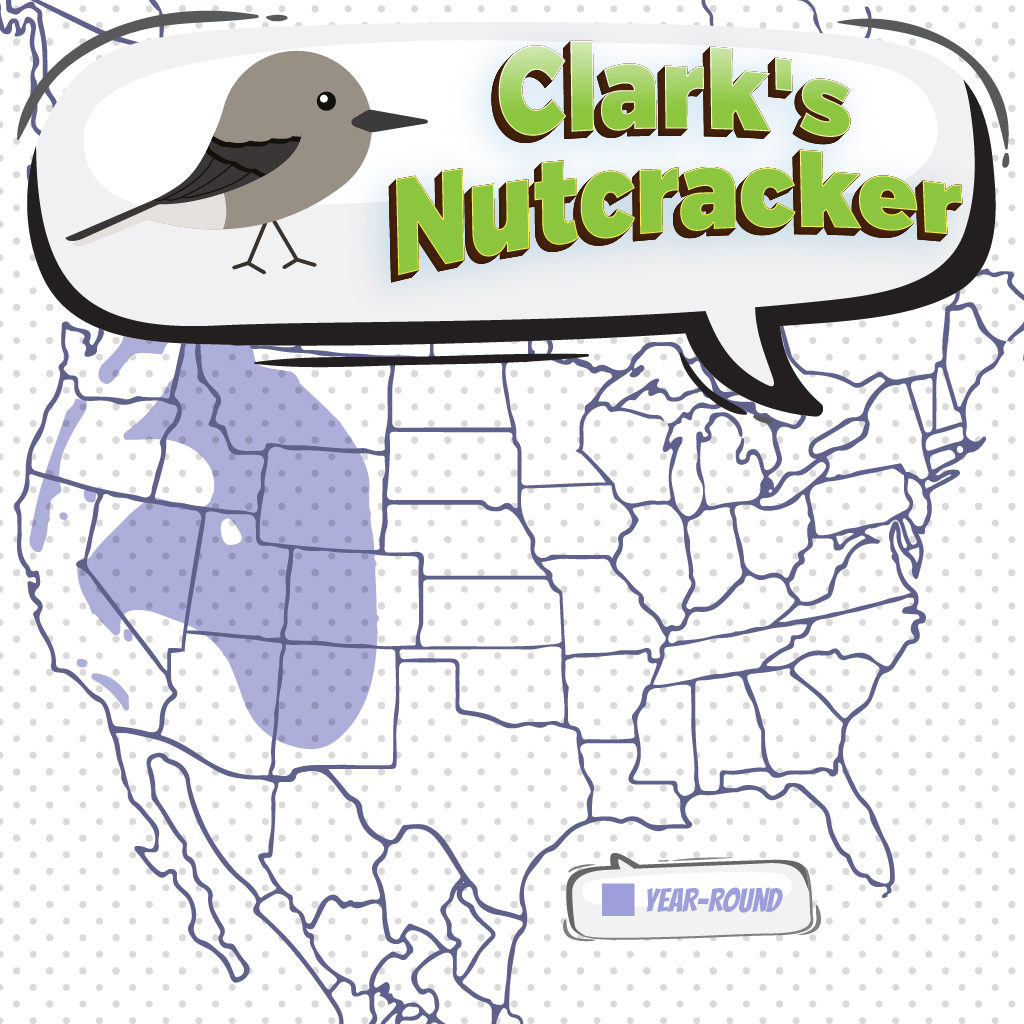
Clark’s Nutcracker
A Clark’s Nutcracker is a fun bird to see while bird watching. Below are some tips to help you identify Clark’s Nutcrackers. We have also put together a list of fun Clark’s Nutcracker t-shirts, Clark’s Nutcracker bird patches, birdhouses, bird feeders, binoculars, stickers, and other fun bird watching items.
About Clark’s Nutcrackers
This is a bird in the crow family that is found in southern Canada and the western parts of the USA.
Description and Identification
Clark’s Nutcrackers are 10.6-11.8 inches long, with an approximate wingspan of 24 inches. These
birds are relatively smaller than other Nutcrackers. They weigh approximately 3.7-5.7oz. Their
plumage is predominantly ash-gray and loose in texture. The wings and tails of these birds are black
and white in color. Male Clark’s Nutcrackers are moderately bigger than the female, hence
displaying sexual dimorphism. The flight of these birds is similar to crows due to the presence of
deep wing beats their technique. Clark’s Nutcrackers are intelligent birds capable of memorizing
sites of cached food for numerous months. As these birds reside in flocks, they use alarm calls to
alert other members of the flock when they are in danger.
Clark’s Nutcracker Size
Length: 10.6 to 11.8 inches
Weight: 3.7 to 5.7 ounces
Both the male and female of the species are of the same average size.

Clark’s Nutcracker Appearance
It has a pale gray body, with white patches on its black wings. It has a white tail which appears split by a black streak running down the middle lengthwise. It has a long, sharp bill that is dagger-shaped.
Clark’s Nutcracker Feeding
Clark’s Nutcrackers are omnivorous, but their main source of nutrition is pine seeds. As these
intelligent birds are opportunistic in their diet, the rest of their diet includes a large variety of foods.
Carrion, voles, toads, small birds, squirrels, insects, and spiders make up a big portion of their
animal diet. Clark’s Nutcrackers use their pointy and sturdy bill to pry out seeds from unripe cones.
Their bills are also useful for hammering and crushing seeds out of their protective shells. These
birds eat seeds until they’re full, and cache the excess seeds for the future. A single Clark’s
Nutcracker can have thousands of caches at varying elevations — each cache contains about 3-4
seeds. These birds can recollect the locations cache sites for about 9 months after caching.
Their diet mainly consists of fruits, seeds (especially pine seeds), berries, insects, carrions, toads, small mammals, and small reptiles.
The Nutcrackers have specially evolved to feed on seeds. They have a dangling pouch under their tongues that allows them to carry 30 to 150 seeds depending on the maturity and size. They bury these seeds and store them in locations that they are able to remember for as long as 6 to 9 months from the moment they store them. Each bird can collect and store up to 98,000 seeds every year.
Clark’s Nutcracker Habitat
Clark’s Nutcrackers prefer living in coniferous forests with elevations of about 3,000-12,000 feet.
During summers these birds can be found in higher elevations, and in the fall they descend to
lower elevations. They choose their habitats depending on the availability of seeds.
The Clark’s Nutcracker lives in coniferous forests at altitudes that range between 3,000 to 12,000 feet.
Range and Migration

Clark’s Nutcrackers, commonly also known as woodpecker crows are passerine birds widespread
in the mountains of western North America. They can be commonly found in Coastal ranges in
Canada, and the mountainous regions in western America. These birds are permanent residents in
western North America — the only migration they undergo is altitude-related. In late September,
they begin to travel to areas with lower elevations to protect themselves from the colder
temperatures.
Clark’s Nutcracker Life and Behavior
Clark’s Nutcrackers travel in large flocks that are made up of mated pairs. During the flight, they produce long, rolling calls to communicate with one another. These flocks allow them to defend themselves against their natural enemies such as hawks, eagles, and owls.
Their mating occurs between January and February. They are monogamous and each pair produces only one brood per year. If a mating fails, the pair waits one year before making another attempt.
The females lay 2 to 6 pale green eggs with brown spots. The incubation of these eggs lasts 18 days, which is done by both parents. The young leave the nest 24 days after hatching but stay with the parents for 3 to 4 months before leaving.
Clark’s Nutcraker Nesting
Clark’s Nutcrackers form pairs in winter months, which last for a long period of time. Although
these birds perform courtship displays throughout the year, these displays are more frequent and
elaborate during the breeding season. Clark’s Nutcrackers have very dynamic courtship displays in
which one bird follows the others at high speeds as both of them perform a variety of swoops and
dives. Feeding and vocalizations are other behaviors common during courtship. Both males and
females participate in constructing the nest in a suitable site considering factors such as food
availability, weather, and elevation. Nests are generally built on coniferous trees on elevations up to
70 feet. These nests are poorly concealed from predators but are built on the leeward side of the
trees to protect them from harsh winds. Females lay 2-6 eggs which are incubated by both sexes for approximately 18 days.
Ornithology
Bird Watching Academy & Camp Subscription Boxes
At Bird Watching Academy & Camp we help kids, youth, and adults get excited and involved in bird watching. We have several monthly subscription boxes that you can subscribe to. Our monthly subscription boxes help kids, youth, and adults learn about birds, bird watching, and bird conservation.
Bird Watching Binoculars for Identifying Clark’s Nutcrackers
The most common types of bird-watching binoculars for viewing Clark’s Nutcrackers are 8×21 binoculars and 10×42 binoculars. Bird Watching Academy & Camp sells really nice 8×21 binoculars and 10×42 binoculars. You can view and purchase them here.
Clark’s Nutcracker T-shirts
If you love the Clark’s Nutcracker you should purchase a Bird Watching Academy & Camp T-shirt. To help support bird conservation we donate 10 percent to bird conservation activities.
Clark’s Nutcracker Iron On Patches
Kids, Youth, and Adults love to collect our Bird Watching Academy & Camp iron-on patches. Our bird-watching patches help you keep track of the birds you have seen and identified. You can also display the patches on our Bird Watching Academy & Camp banners.
The Clark’s Nutcracker is a great iron-on patch to start your collection with. The patches are durable and can be sewn on or ironed on to just about anything.
Clark’s Nutcracker Stickers
Stickers are a great way for you to display your love for bird watching and the Clark’s Nutcracker. We sell a monthly subscription sticker pack. The sticker packs have 12 bird stickers. These sticker packs will help your kids learn new birds every month.
Bird Feeders for Clark’s Nutcracker
There are many types of bird feeders. Here are our favorite bird feeders for your backyard. We use all of these bird feeders currently. Kids will have a great time watching birds eat at these bird feeders. Using this collection of bird feeders will provide a wide variety and many types of birds.
Best Bird Houses for Clark’s Nutcracker
There are many types of birdhouses. Building a birdhouse is always fun but can be frustrating. These 4 birdhouses have become our favorites. Getting a birdhouse for kids to watch birds grow is always fun. We spent a little extra money on these birdhouses but they have been worth the higher price and look great.









